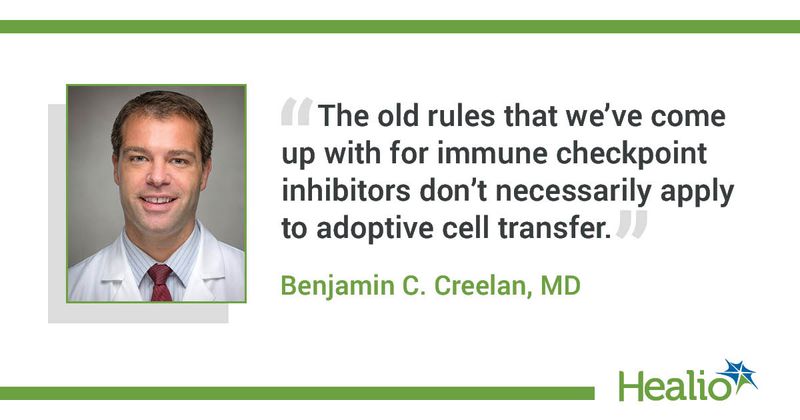Cell therapy plus nivolumab regimen induces durable remissions in advanced lung cancer
The combination of tumor-infiltrating lymphocytes and nivolumab induced tumor regression among more than two-thirds of patients with stage IV non-small cell lung cancer, according to results of a phase 1 study published in Nature Medicine.
The study also achieved its primary safety endpoint.

Treatment options are limited for patients after second-line therapy for advanced lung cancer, according to Benjamin C. Creelan, MD, associate member of the department of thoracic oncology at Moffitt Cancer Center.
The results of this study — which Creelan called a “first-in-principle trial for lung cancer” — suggest tumor-infiltrating lymphocytes (TILs) can be effective. Some of the patients who achieved durable responses to the combination represent a population that typically does not respond well to immunotherapy, such as those who have never smoked or harbor EGFR mutations.
“[The results] show that the old rules that we have come up with for immune checkpoint inhibitors don't necessarily apply to adoptive cell transfer,” Creelan told Healio.
The phase 1 pilot study evaluated the safety and efficacy of TILs in combination with nivolumab (Opdivo, Bristol Myers Squibb) for patients with stage IV NSCLC.
Creelan and colleagues enrolled 20 patients (median age, 54 years; range 38-75; 50% current or former smokers) who never received anti-PD-1/PD-L1 therapy.
Study participants had fragments of their tumors excised for use in TIL manufacturing. TILs were successfully expanded using established NCI protocol for 95% of patients at a median dose of 95 billion CD3-postive cells. Trial participants then received at least four cycles of 240 mg nivolumab every 2 weeks.
Nivolumab treatment continued until disease progression, at which time patients underwent lymphodepletion and TIL therapy.
Sixteen patients received the entire regimen of preconditioning lymphodepletion with cyclophosphamide and fludarabine followed by the TIL infusion and interleukin (IL)-2 to promote TIL activity.
Eleven (69%) of 16 patients exhibited tumor regression on CT scan 1 month after TIL therapy. Six (46.1%) of 13 evaluable patients achieved radiographic response.
Two patients remained in ongoing complete response 1.5 years after treatment completion. Two others maintained clinical remission after having local ablative therapy for newly developed lesions.
Median OS had not been reached for the intent-to-treat population or for those who received TIL therapy.
Even though this was a pilot study, the efficacy results suggest the combination of TILs and nivolumab can provide more durable responses than an immune checkpoint inhibitor alone for patients who are poor candidates for immunotherapy, Creelan said.
“That is really a hallmark of TILs — the potential for these durable remissions,” Creelan said. “Several of our patients are still in a complete response or have no measurable disease.”
Researchers attributed most treatment-related adverse events to the lymphodepletion regimen and the IL-2 used to facilitate TIL activation.
However, two patients died during the study; both had a decline in ECOG performance status and required supplemental oxygen before lymphodepletion. These deaths prompted the researchers to implement a more stringent performance status requirement for patients subsequently treated during the study.
Researchers reported a 12.5% rate of treatment-related severe adverse events, which met the prespecified safety endpoint of less than 17%.
The most common treatment-related toxicities were hematologic in nature and resolved within 1 month of TIL infusion.
Despite only being available through clinical trials, TILs would address an unmet need for patients healthy enough to tolerate the toxicity associated with preconditioning lymphodepletion regimen and the post-TIL infusion use of IL-2, Creelan said.
“The amount of enthusiasm I see from surgeons, patients and providers from the referrals that we get for these trials is really astounding,” he told Healio.
Response rates for second- and third-line therapy in stage IV lung cancer typically are between 10% and 15%, and most patients maintain active responses to therapy for a few months, Creelan said.
“It would really be impactful to have [a] commercially available product for patients outside of a trial,” he said.
Patients who experienced disease progression while receiving first-line therapies like a tyrosine kinase inhibitor often are left looking for a “nuclear option,” Creelan said. This includes use of chemotherapy that may provide disease control for a few months at most.
Results of the pilot study show TILs have the potential to provide considerable benefit, he said.
“You're swinging for the fences instead of just going for a bunt,” Creelan said. “You're going for a high-risk, high-reward type of a treatment. Yes, there are more toxicities, but especially for our slightly younger, fitter or more motivated patients, they want to aim for the fences.”
For more information:
Benjamin C. Creelan, MD, can be reached at Moffitt Cancer Center, 12902 USF Magnolia Drive, Tampa, FL 33612.


